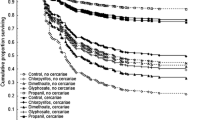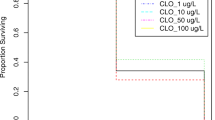Abstract
We tested the hypothesis that exposure of leopard frogs (Rana pipiens) to agricultural pesticides can affect the infection dynamics of a common parasite of ranid frogs, the lungworm Rhabdias ranae. After a 21-day exposure to sublethal concentrations of a pesticide mixture composed of atrazine, metribuzin, aldicarb, endosulfan, lindane and dieldrin, or to control solutions (water, dimethyl sulfoxide), parasite-free juvenile frogs were challenged with 30 infective larvae of R. ranae. Approximately 75% of the larvae penetrated the skin and survived in both exposed and control animals, suggesting that pesticides did not influence host recognition or penetration components of the transmission process. Rather, we found that the migration of R. ranae was significantly accelerated in hosts exposed to the highest concentrations of pesticides, leading to the establishment of twice as many adult worms in the lungs of frogs 21 days post-infection. Pesticide treatment did not influence the growth of lungworms but our results indicate that they matured and reproduced earlier in pesticide-exposed frogs compared to control animals. Such alterations in life history characteristics that enhance parasite transmission may lead to an increase in virulence. Supporting evidence shows that certain components of the frog immune response were significantly suppressed after exposure to the pesticide mixture. This suggests that the immune system of anurans exerts a control over lungworm migration and maturation and that agricultural contaminants can interfere with these control mechanisms. Our results also contribute to the ongoing debate regarding the role that anthropogenic factors could play in the perplexing disease-related die-offs of amphibians observed in several parts of the world.



Similar content being viewed by others
References
Alford RA, Richards SJ (1999) Global amphibian declines: a problem in applied ecology. Annu Rev Ecol Syst 30:133–165
Baker MR (1979a) Seasonal population changes in Rhabdias ranae Walton, 1929 (Nematoda:Rhabdiasidae) in Rana sylvatica of Ontario. Can J Zool 57:179–183
Baker MR (1979b) The free-living and parasitic development of Rhabdias spp. (Nematoda:Rhabdiasidae) in amphibians. Can J Zool 57:161–178
Bollinger TK, Mao J, Shock D, Brigham RM, Chinchar VG (1999) Pathology, isolation and molecular characterization of an iridovirus from tiger salamanders in Saskatchewan. J Wildl Dis 35:413–429
Boroskova Z, Soltys J, Benkova M (1995) Effect of mercury on the immune response and mean intensity of Ascaris suum infection in guinea pigs. J Helminthol 69:187–194
Boroskova Z, Dvoroznakova E (1997) The effect of cadmium on the immune behaviour of guinea pigs with experimental ascariasis. J Helminthol 71:139–146
Bull JJ (1994) Virulence. Evolution 48:1423–1437
Bush AO, Lafferty KD, Lotz JM, Shostak AW (1997) Parasitology meets ecology on its own terms: Margolis et al. revisited. J Parasitol 83:575–593
Carey C, Cohen N, Rollins-Smith L (1999) Amphibian declines: an immunological perspective. Dev Comp Immunol 23:459–472
Carlson EA, Li Y, Zelikoff JT (2002) Exposure of Japanese medaka (Orzias latipes) to benzo-a-pyrene. Aquat Toxicol 56:289–301
Christin M-S, Gendron AD, Brousseau P, Ménard L, Marcogliese DJ, Cyr D, Ruby S, Fournier M (in press) Effects of agricultural pesticides on the immune system of Rana pipiens and on its resistance to parasitic infection. Environ Toxicol Chem
Cunningham AA, Langton EES, Bennett PM, Lewin JF, Drury SEN, Gough RE, MacGregor SK (1996) Pathological and microbiological findings from incidents of unusual mortality of the common frog (Rana temporaria). Phil Trans R Soc Lond B 351:1539–1557
Daszak P, Berger PL, Cunningham AA, Hyatt AD, Green DE, Speare R (1999) Emerging infectious diseases and amphibian population declines. Emerg Infect Dis 5:1–14
Day T (2001) Parasite transmission modes and the evolution of virulence. Evolution 55:2389–2400
Ebert D, Herre EA (1996) The evolution of parasitic diseases. Parasitol Today 12:96–101
Esch GW, Fernández JC (1993) A functional biology of parasitism. Ecological and evolutionary implications. Chapman and Hall, New York
Ewald P (1994) Evolution of infectious disease. Oxford University Press, Oxford
Frank SA (1996) Models of parasite virulence. Q Rev Biol 71:37–38
Garnick E (1992) Parasite virulence and parasite-host coevolution: a reappraisal. J Parasitol 78:381–386
Gendron AD, Bishop CA, Fortin R, Hontela A (1997) In vivo testing of the functional integrity of the corticosterone-producing axis in mudpuppy (Amphibia) exposed to chlorinated hydrocarbons in the wild. Environ Toxicol Chem 16:1694–1706
Gilbert M, Leclair RJ, Fortin R (1994) Reproduction of the northern leopard frog (Rana pipiens) in floodplain habitat in the Richelieu River, P. Quebec, Canada. J Herpetol 28:465–470
Giroux I (1999) Contamination de l'eau par les pesticides dans les régions de culture de maïs et de soya au Québec, Campagnes d'échantillonnage de 1996, 1997 et 1998. Ministère de l'Environnement, Direction des écosystèmes aquatiques, Québec
Goater CP (1992) Experimental population dynamics of Rhabdias bufonis (Nematoda) in toads (Bufo bufo): density dependence in the primary infection. Parasitology 104:179–187
Goater CP (1994) Growth and survival of postmetamorphic toads: interactions among larval history, density, and parasitism. Ecology 75:2264–2274
Goater CP, Vandenbos RE (1997) Effects of larval history and lungworm infection on the growth and survival of juvenile wood frog (Rana sylvatica). Herpetologica 53:331–338
Goater CP, Ward PI (1992) Negative effects of Rhabdias bufonis (Nematoda) on the growth and survival of toads (Bufo bufo). Oecologia 89:161–165
Goater CP, Semlitsch RD, Bernasconi MV (1993) Effects of body size and parasite infection on the locomotory performance of juvenile toads, Bufo bufo. Oikos 66:129–136
Gosner VA (1960) A simplified table for staging anuran embryos and larvae with notes on identification. Herpetologica 16:203–210
Hoole D (1997) The effects of pollutants on the immune response of fish: implications for helminth parasites. Parassitologia 39:219–225
Houlahan JE, Findlay CS, Schmidt BR, Meyer AH, Kuzmin SL (2000) Quantitative evidence for global amphibian population declines. Nature 404:752–755
Institute of Laboratory Animal Resources (1974) Amphibians: guidelines for the breeding, care and management of laboratory animals. National Research Council, Subcommittee on Amphibian Standards, National Academy of Sciences, Washington, D.C.
Kiesecker JM (2002) Synergism between trematode infection and pesticide exposure: a link to amphibian limb deformities in nature? Proc Natl Acad Sci 99:9900–9904
Laurance WF, McDonald KR, Speare R (1996) Epidemic disease and the catastrophic decline of Australian rain forest frogs. Conserv Biol 10:406–413
Luebke RW, Hodson PV, Faisal M, Ross PS, Grasman KA, Zelikoff J (1997) Aquatic pollution-induced immunotoxicity in wildlife species. Fundam Appl Toxicol 37:1–15
Maloy WL, Kari UP (1995) Structure-activity studies on magainins and other host defense peptides. Biopolymers 37:105–122
Marcogliese DJ (1997) Fecundity of sealworm (Pseudoterranova decipiens) infecting grey seals (Halichoerus grypus) in the Gulf of St. Lawrence, Canada: lack of density-dependent effects. Int J Parasitol 27:1401–1409
Morand S (1996) Life-history traits in parasitic nematodes: a comparative approach for the search of invariants. Funct Ecol 10:210–218
Poulin R, Combes C (1999) The concept of virulence: interpretations and implications. Parasitol Today 15:474–475
Read AF, Skorping A (1995) The evolution of tissue migration by parasitic nematode larvae. Parasitology 111:359–371
Riffkin M, Seow H-F, Jackson D, Brown L, Wood P (1996) Defence against the immune barrage: helminth survival strategies. Immunol Cell Biol 74:564–574
Rondeau B (1996) Pesticides dans les tributaires du fleuve Saint-Laurent 1989–1991. Environnement Canada-Région du Québec, Conservation de l'Environnement, Centre Saint-Laurent, Montreal
Schallig HDFH (2000) Immunological responses of sheep to Haemonchus contortus. Parasitology 120:S63–S72
Soltys J, Boroskova Z, Dvoroznakova E (1997) Effect of concurrently administered copper and mercury on phagocytic cell activity and antibody levels in guinea pigs with experimental ascariasis. J Helminthol 71:339–344
Taylor SK, Williams ES, Mills KW (1999) Effects of malathion on disease susceptibility in Woudhouse's toads. J Wildl Dis 35:635–541
Tinsley RC (1995) Parasitic disease in amphibians: control by regulation of worm burdens. Parasitology 111:S153–S178
Torgensen PR, Llyod S (1992) The B-cells dependence of Haemonchus contortus antigen-induced lymphocyte proliferation. Int J Parasitol 54:244–246
Torgerson PR, Llyod S (1993) The same fractions of Haemonchus contortus soluble antigen induce lymphocyte responses in naive lambs and immune sheep. Res Vet Sci 54:244–246
Vermeer BJ, Hurks M (1996) The clinical immunotoxicity of pesticides. J Toxicol Environ Health 24:149–154
Viney M (2002a) How do host immune responses affect nematode infections? Trends Parasitol 18:63–66
Viney M (2002b) Developing worms need the host immune system. Trends Parasitol 18:57
Wagner G (1997) Status of the Northern leopard frog (Rana pipiens) in Alberta. Alberta Environmental Protection, Wildlife Management Division, Edmonton
Waye HL, Cooper JM (2001) Status of the Northern leopard frog (Rana pipiens) in the Creston valley wildlife management area. Columbia Basin Fish and Wildlife Compensation Program, Nelson
Weyts FAA, Cohen N, Flik G, Verburg-van Kemenade BML (1999) Interactions between the immune system and the hypothalmo-pituitary-interrenal axis in fish. Fish Shellfish Immunol 9:1–20
Acknowledgements
Lucie Ménard, Alain Branchaud and Stéphanie Gagné are acknowledged for their assistance in the laboratory and with frog rearing. We are also grateful to Dr Cameron Goater for sharing his expertise with culturing of lungworms and experimental infection of frogs. The image-analysing system of the Université de Montréal was used with permission from Bernadette Pinel-Aloul and technical assistance of Louise Pelletier. We thank Drs Cameron Goater and Robert Poulin, as well as two anonymous reviewers, for commenting on the manuscript. This project received the financial support of the Toxic Substances Research Initiative program (grant no. 46).
Author information
Authors and Affiliations
Corresponding author
Rights and permissions
About this article
Cite this article
Gendron, A.D., Marcogliese, D.J., Barbeau, S. et al. Exposure of leopard frogs to a pesticide mixture affects life history characteristics of the lungworm Rhabdias ranae . Oecologia 135, 469–476 (2003). https://doi.org/10.1007/s00442-003-1210-y
Received:
Accepted:
Published:
Issue Date:
DOI: https://doi.org/10.1007/s00442-003-1210-y




